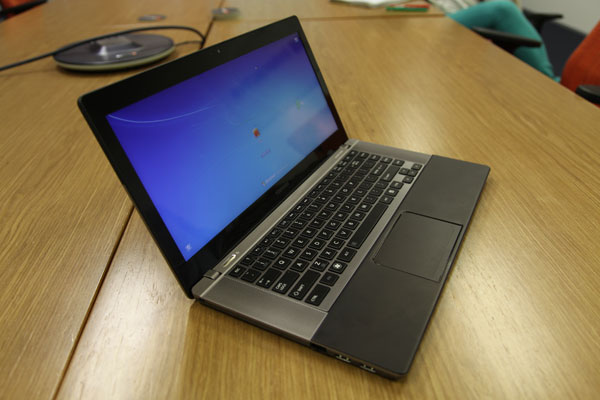Toshiba embraces Ivy Bridge and 21:9 cinema ratio

Toshiba has refreshed much of its notebook line, including its 'world's-thinnest' Portégé ultrabook, with Intel's 'Ivy Bridge' Core processors.
Most of the updated models are being touted as business-friendly, even the Portégé Z930, a follow-on from last year's Z830. Toshiba's launch on Tuesday also included its first 14-inch ultrabook, the Satellite U840, a new Android tablet and what the manufacturer says is the first ever laptop screen to deliver a true cinematic 21:9 aspect ratio.

The screen on Toshiba's Satellite U840W has an unusually wide aspect ratio. Image credit: Craig Simms/CNET Australia
The Ivy Bridge platform has better integrated graphics than its predecessors, and the Z930 does not offer the option of a discrete GPU — neither does the Satellite U840, a cheaper and heavier 14-inch ultrabook alternative, nor the Portégé R930, a business version that has a 13.3-inch screen.
However, discrete graphics are available in the larger iterations of the business-friendly R-series, namely the 14-inch Tecra R940 and 15.6-inch Tecra R950. These will come out in the third quarter at a starting price of £899.
The R-series laptops are than their consumer or prosumer cousins and offer better security and administrative features, and the R940 and R950 also feature optical drives.
The main administrative boost is the Smart Client Manager, developed by Toshiba and IBM. The software draws on security, patch management and power control elements of IBM's Tivoli suite.
The Satellite U840W is similar to the standard U840, but it offers a few key differences. It takes more RAM — up to 10GB rather than up to 8GB — and it also features a 21:9 screen aspect ratio and harmon/kardon speakers.
Even with the now-standard 16:9 and 16:10 laptop aspect ratios, widescreen movies are still displayed with black borders above and below. The 21:9 ratio, embodied in the U840W's 14.4-inch screen with a 1792 x 768-pixel resolution, eliminates those borders.
The U840W also comes with a split-screen utility that makes it possible to view content in the standard 16:9 ratio while having a second 5:9 window on the side. It will come out in the third quarter at a starting price of £899. The U840 will be available at around the same time, at a starting price of £599.
The new Android tablet, the AT300, is an update to the recent AT200. The AT200 was notable for being very thin at 7.7mm, but it was also a bit underpowered, having only a dual-core processor. The AT300 has a quad-core Tegra 3 processor, but it is also thicker at 8.95mm and heavier at 590g to the AT200's 535g.
The AT300 will appear in the second quarter, but Toshiba has not yet announced pricing.
Also on Tuesday, Toshiba launched the LX830 all-in-one PC, which is geared towards entertainment. The PC comes with a 23-inch screen that can optionally be touch-capable. It also features Blu-ray and up to 2TB of storage.
The LX830 will start at £599 including VAT, and will be available in the third quarter.